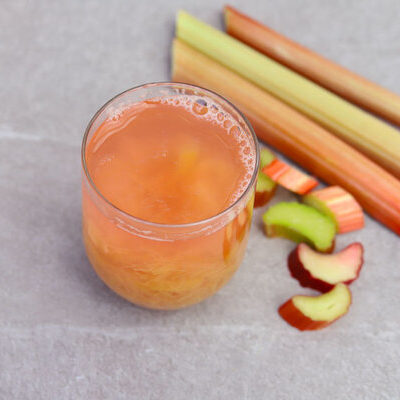
Rhubarb Juice
What is Rhubarb Juice?
Rhubarb juice is a drink made from rhubarb stalks. These stalks can be bright pink, light pink, or pale green. Due to their high concentration of oxalic acid, rhubarb leaves are poisonous to humans.
- For this reason, cooks only use rhubarb stalks in sauces, glazes, pie fillings, and baked goods.
- Rhubarb is popularly found in the North American state of Alaska.
The ten best cultivars of rhubarb are:
- Cherry Red
- Chipman’s Canada Red
- Crimson Red
- German Wine
- Glaskin’s Perpetual
- Hardy Tarty
- Holstein’s Bloodred
- KangaRhu
- Prince Albert
- Riverside Giant
Origin of rhubarb juice
Rhubarb originated in central Asia over five thousand years ago. The Chinese used the plant for its medicinal properties. The ancient Arabs, Greeks, and Romans also knew about this vegetable. Marco Polo later discovered this vegetable on his journey to China. There was massive cultivation of rhubarb in the mountains of Sukchu, where East Indian traders would buy it and move it around the world.
In the 1700s, the seeds and roots of this vegetable reached Western Europe. People in France found out that the vegetable’s stalks were edible and produced a sour sauce with them. The British did not accept this vegetable immediately and took a while to experiment with it, but eventually generated suitable tasting varieties. This vegetable made it to North America in the late 1700s, where it was used as a medicine, as well as in many foods. Rhubarb juice is one of the ways people still consume this vegetable.
Function
In the kitchen, rhubarb juice can be mixed with gin, rum, and other spirits to craft cocktails. This juice can also be used to make soda or flavor sweets. It can even be frozen to make popsicles.
Nutrition
In the juice from one stalk of rhubarb (51g), there are:

Rhubarb juice has significant health benefits for the body. Here are some of them:
- It is a good source of vitamin K1, which improves bone health and blood clotting.
- This juice contains compounds that might be able to prevent cancer.
- It can promote a healthy digestive system by assisting bowel movements.
- It contains trace amounts of copper and iron that can help blood circulation.
- This juice may help with weight loss because of its low-calorie content.
Rhubarb stalks, an integral component in making the juice, may contain a significant amount of calcium oxalate, depending on the variety. People respond to calcium oxalate in different ways. However, too much calcium oxalate in the body may cause kidney stones in some individuals.
Commercial production
The most crucial step in the commercial production of this juice is to wash and mash the rhubarb stalks in a perforated disk mill. Then, the liquid is extracted from the mash. This juice does not necessarily require heating or enzyme application to produce a good yield. After the liquid is extracted, the juice can be bottled, labeled, and stored until ready to be sold.
Application
Rhubarb juice is easy to make, simply follow the steps below. All you need is rhubarb stems and water.
- First, rinse the rhubarb stems in water and chop them into slices.
- Next, place the pieces of the stems in a pot filled with cold water.
- Boil the water with the stems in it. Then, lower the heat and allow the contents to simmer.
- Then, turn off the heat and allow the mixture to cool.
- Strain the juice into a jug to separate it from the stems. Place the fluid in the fridge for 30 minutes to allow it to settle.
- After 30 minutes, separate the pink juice from the sediment in the jug. Drink and enjoy!
This juice can last for about a week in the refrigerator. When you go to the store to buy rhubarb, be sure to get firm stems with fresh leaves and no blemishes.
Rhubarb recipes
This juice can create delicious juices and cocktails. Here are some recipes you can try:
- Rhubarb Lemonade
- Homemade Rhubarb Syrup
- Rhubarb Juice with Ginger, Orange & Apple
- Rhubarb Gin and Plum Cake
- Rhubarb-Fennel Gin Cocktail
FDA regulation
The Food and Drug Administration classifies rhubarb as a raw agricultural product. It oversees the growing, harvesting, and packaging of this commodity. The FDA also provides the labeled percentage of rhubarb juice from its beverage or concentrate using Brix levels. Rhubarb juice must contain at least 5.7 percent concentrate to be in compliance with FDA regulations.
References
“Grow Your Own Rhubarb.” Oregon State University Extension Service, Oregon State University Extension Service, catalog.extension.oregonstate.edu/sites/catalog/files/project/pdf/ec797.pdf.
Fulton, April. “Four Things You Didn’t Know About Rhubarb.” National Geographic, National Geographic, 24 Feb. 2015, www.nationalgeographic.com/culture/food/the-plate/2015/02/24/four-things-you-didnt-know-about-rhubarb/.
Foster, Kelli. “Everything You Need to Know About Rhubarb.” www.kitchn.com, Apartment Therapy, LLC., 17 Apr. 2020, https://www.thekitchn.com/what-is-rhubarb-203609
“CFR – Code of Federal Regulations Title 21.” accessdata.fda.gov, U.S Food & Drug Administration, 1 Apr. 2019, https://www.accessdata.fda.gov/scripts/cdrh/cfdocs/cfcfr/CFRSearch.cfm?fr=112.1&SearchTerm=rhubarb
